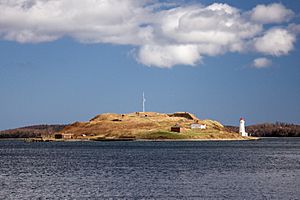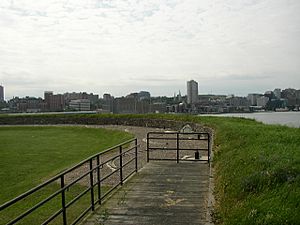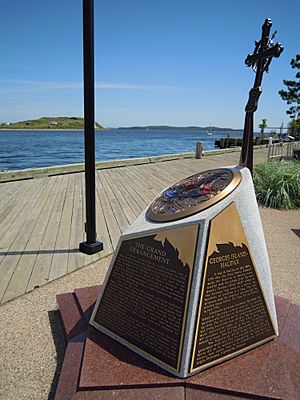Georges Island (Nova Scotia) facts for kids
Georges Island is a special island right in the middle of Halifax Harbour in Nova Scotia, Canada. It's like a big, rounded hill made of dirt and rocks, left behind by ancient glaciers. The island is named after George II of Great Britain, a former king. It's home to a historic fort called Fort Charlotte, which was named after King George's wife, Charlotte of Mecklenburg-Strelitz. This fort was built a long time ago, in 1750, during a conflict known as Father Le Loutre's War. Today, Georges Island is recognized as a National Historic Site, meaning it's a very important place in Canadian history. You can even visit the island for tours during certain times of the year!
Contents
Island History and Fort Charlotte
Georges Island has had a few different names over the years. At first, it was called île à la Raquette, which means Snowshoe Island. For a short time, it was known as île d'Enville, named after a French leader who was buried there. In 1749, it was officially named "George Island" after King George II. Finally, in 1963, its name was changed to "Georges Island."
When Edward Cornwallis arrived in Halifax in 1749, forts were built to protect the harbour. One was on Citadel Hill (Fort George) and the other was Fort Charlotte on Georges Island, built in 1750.
A Place for Prisoners
Georges Island played a big role as a prison during several wars.
Seven Years' War Prisoners
During the Seven Years' War, after a British victory in a sea battle near Newfoundland in 1755, about two thousand French sailors were held prisoner on the island.
Acadian Prisoners
Georges Island was one of the main places where Acadian people were held prisoner during the Expulsion of the Acadians. This sad event happened between 1755 and 1763. The Acadians were French-speaking settlers who lived in Nova Scotia. Many were forced to leave their homes, and some were kept on Georges Island.
Historians believe that around 1,660 Acadians were held on the island at different times during this period, with up to 600 prisoners at once. These prisoners were not allowed to own land and depended on others for food. Many Acadian men also worked on building roads, fishing, and cutting wood in the area.
American Revolution Prisoners
During the American Revolution, soldiers from the 84th Regiment of Foot (Royal Highland Emigrants) were stationed at Fort Charlotte. Their job was to protect Halifax Harbour from American privateers, who were like armed ships that attacked British vessels. Many American privateers were captured and held prisoner at the fort during this war.
Halifax Defence Complex
For nearly 200 years, from the mid-1700s to the Second World War, Georges Island was an important part of Halifax's defenses. It worked together with other forts like Citadel Hill (Fort George). There are many old stories about the island, including tales of hidden tunnels and its past as a prison camp and a quarantine station for people arriving by ship.
The Georges Island Lighthouse was built on the island in 1876 to help guide ships. The first wooden lighthouse burned down in 1916. A new, stronger concrete lighthouse was built in 1917. It was operated by a lighthouse keeper until 1972, when it became automated.
Georges Island Today
As of November 2020, Georges Island is open for tours on weekends during the tourist season, usually until Thanksgiving.
In 2009, the Canadian government provided $3.5 million to add water, sewer, and electricity to the island. This was meant to be the first step to open the island more widely to visitors. However, more work is still needed, like building restrooms and a visitor center. For a long time, you needed special permission from the Canadian Government to visit.
Local fishermen know that Georges Island has many wild blueberries. You might also spot black garter snakes there! The island is part of the Halifax Regional Municipality. Besides the old ruins of Fort Charlotte, you can also see the Georges Island Lighthouse and the house where its keeper used to live. The Canadian Coast Guard also has an unmanned radar station on the island, which started operating in 1977.





